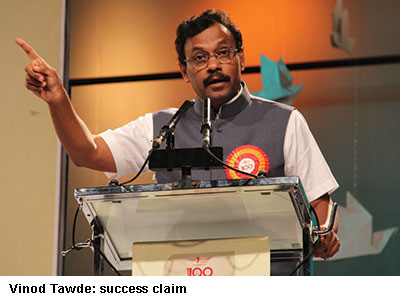
The 13th annual survey, conducted by the globally respected Pratham Education Foundation (estb. 1994), is a massive, unprecedented initiative for which over 30,000 volunteers — mainly college students and employees of partner NGOs — fanned out across all 596 districts of rural India and field tested a nationally representative sample of 546,527 classes I-VIII children from 19,765 households to assess their basic literacy and numeracy capability.
According to ASER 2018 the proportion of class V children in Maharashtra who can read and comprehend class II textbooks has risen from 51.7 percent in 2014 to 66 percent in 2018. Similarly, the percentage of class V children who can do simple division sums has almost doubled from 16.6 percent in 2014 to 31.7 percent in 2018.
However, the latest ASER report paints a dismal picture of enabling infrastructure available to the 3.7 million children enrolled in rural primaries of India’s most industrialised state (pop. 112 million). Despite the Right of Children to Free and Compulsory Education (RTE) Act, 2009 specifying norms for physical infrastructure such as drinking water, separate toilets for boys and girls, playgrounds etc, 37 percent of rural schools in the state don’t provide separate toilets for girl children, and only 70.9 percent provide safe drinking water.
Moreover, despite being India’s richest large state in terms of per capita income (Rs.1.65 lakh per capita in 2017-18), according to ASER 2018, 23 percent of rural primaries are non-compliant with the 1:30 teacher-pupil ratio prescribed by the RTE Act. With teacher vacancies in government primary/elementary schools estimated at 30,000 and 82 percent of the state government’s allocation of Rs.51,565 crore for school education being absorbed by teachers’ salaries, recruitment for government schools has been frozen since 2012 after fraudulent and surplus appointments came to light.
Nevertheless, Maharashtra’s education minister Vinod Tawde tweeted: “Average score showed an improvement of approx. 30 percent in math and 15 percent in languages, reflecting the success of efforts towards educational innovation in Maharashtra.”
All this is very well and the minister’s claim that the condition of schools in Maharashtra’s rural primaries is well above average is credible, but it’s hardly a cause for satisfaction. For one, the national average is dragged down by the pathetic condition of schools in the rural hinterlands of the BIMARU (Bihar, Madhya Pradesh, Rajasthan and Uttar Pradesh) states of North India. Secondly, it needs to be borne in mind that Maharashtra is the country’s most industrially developed state with several rural pockets enjoying high productivity and prosperity. Moreover it enjoys well above the average national income, and its administrative capital Mumbai contributes an estimated 38 percent of the Central government’s annual direct tax revenue while hosting the largest number of dollar billionaires.
Against this backdrop, the condition of its rural primaries is pitiful. According to ASER 2018, 44 percent of class II and 37.9 percent of class IV children in the state’s rural upper primaries (classes I-VIII) “were observed” (by Pratham volunteers) to be learning in multigrade classrooms, indicating inadequate capacity and/or teacher shortages. And although 98 percent of rural primaries have toilet facilities, in 28 percent they were not useable. Moreover 11.6 percent are without libraries, and 35 percent don’t have computers.
Clearly, the condition of vitally important rural primaries in India’s richest and most industrialised state, which needs a steady supply of well-educated and skilled youth for its fields and factories, should be better. Being above the national average in terms of infrastructure and learning outcomes is no cause for satisfaction.
Dipta Joshi (Mumbai)